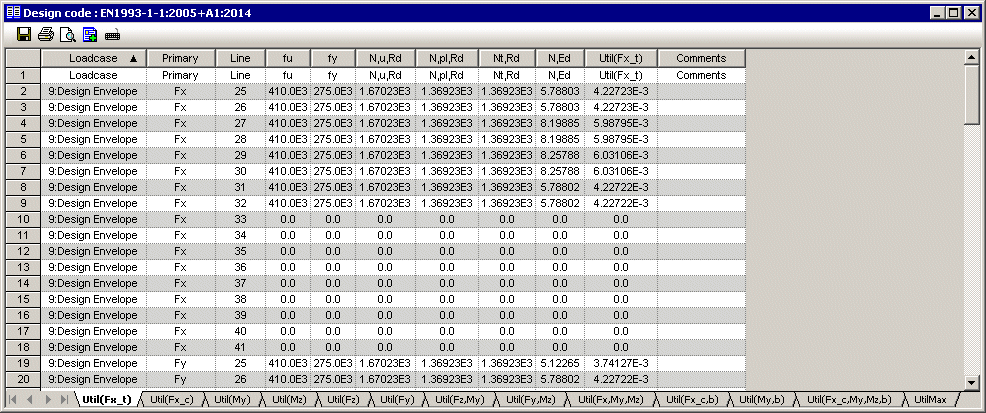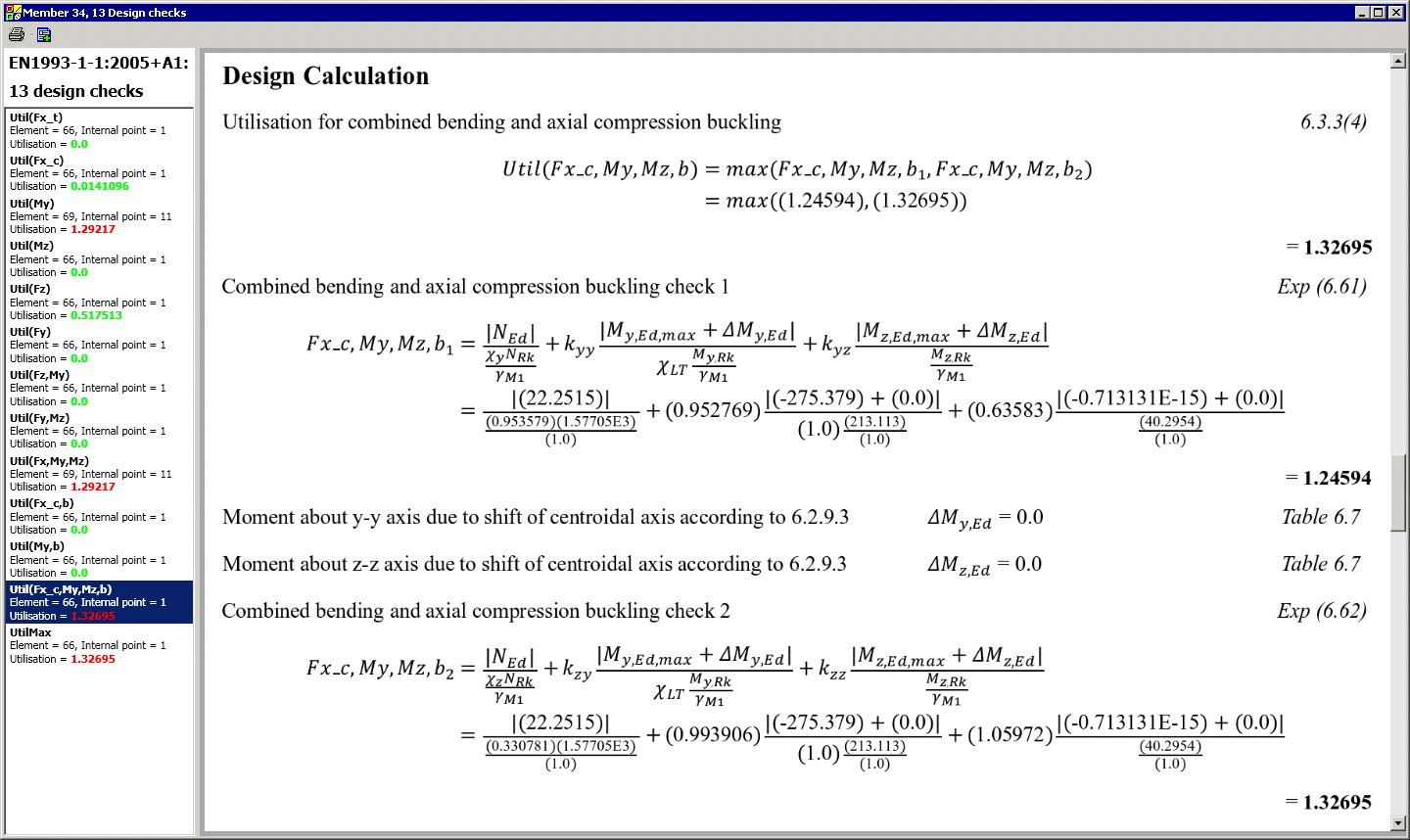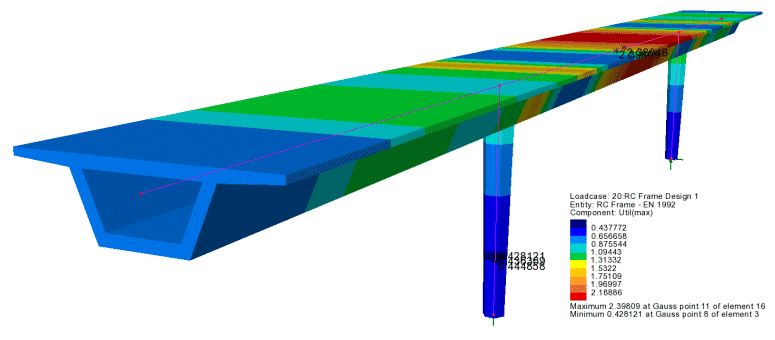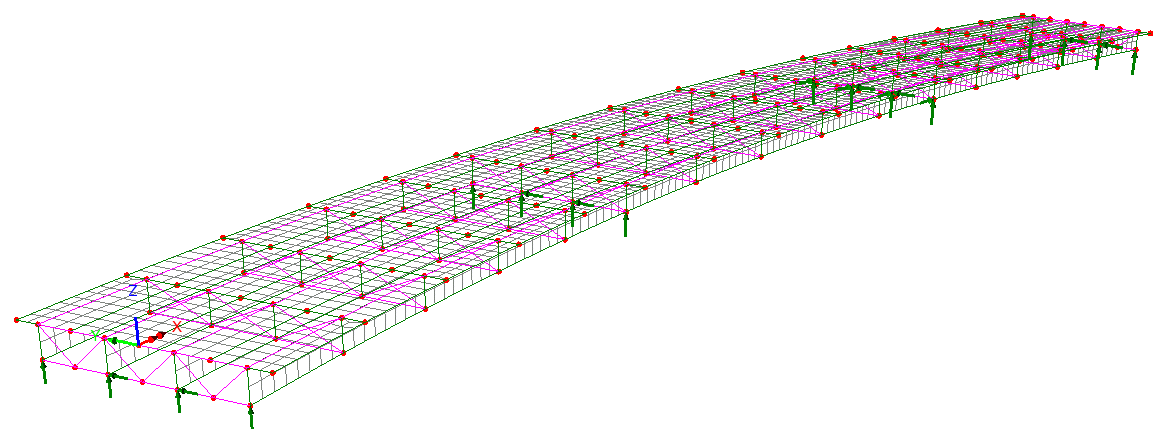Software Tour
Design code facilities
Two software options
allow for design checking of members in steel and reinforced concrete
frames.
Steel
Frame
Design
The Steel
Frame Design software option provides full details of all calculations
made, referencing all relevant clauses and equations from
a design code - giving a step-by-step calculation transparency
normally only found in simple frame analysis software.
Design codes supported
include:
- AASHTO
LRFD 7th, 8th, 9th Edition
- ANSI
/ AISC-360 (2016)
- AS
4100-1998 Steel Structures (Australia)
- BS5400-3
2000
- CSA
S6-14 Canadian Highway Bridge Design Code
- EN1993-1-1: 2005+A1:2014
- EN1993-2:
2006
- GB50017-2017
with more being added
with each release.

- Produce a tabular
summary of design check results for selected members and
loadcases. Save results for use with Microsoft Excel or save to a
text format.
- Add results to a
model report, and each time the report is generated design summary
data will be updated to match the current state of the model.

- Generate formatted
member reports to investigate the design calculations carried out
for particular members. These show all calculations made and
reference clauses and equations from the code.
- Create individual
steel member design reports and optionally append to a main model
report.
- Define model report
templates to speed reproduction of similar content.

RC Frame Design
Use the RC
Frame Design software option to carry out checking of reinforced
concrete members subject to bending and axial force at Ultimate Limit
State (ULS) and Serviceability limit states (SLS). Regular, arbitrary
shaped, tapering and voided members are supported. Layers of
reinforcement are defined for each cross-section along with how
individual reinforcement arrangements apply over the lengths of lines
representing concrete members.

- View results as
utilisation ratios on the model, or as a tabular summary that allows
drilling-down into detailed results and creation of interaction
diagrams for selected members and locations. Results can be added to a
report.

Design codes
supported:
- AASHTO LRFD 8th, 9th
Edition.
- ACI 318-19
- AS5100.5:2017
- CSA S6-14
- EN1992-1:2004 - EN
1992-1-1:2004 +A1 Eurocode 2
- EN1992-2:2005 -
EN1992-2: 2005 Eurocode 2
- IRC:112-2011
with more being added
with each release.
Composite
Deck Design
The Composite
Deck Design software option enables design checking of members /
sections along composite bridge decks to AASHTO LRFD 8th Edition, or
EN1994. For both, colour coded values easily indicate results that
pass or fail.

- For AASHTO
LRFD 8th and 9th Edition, design check results are displayed in a
summary format that allows drilling-down to view full
details of the calculations made, referencing all relevant
clauses and equations from the design code. Full details of
the design checks can also be written to a model report,
which updates automatially when it is requested.
-
For
EN 1994, design calculations cover ULS bending, stress,
shear and interaction; SLS stress, web breathing and
cracking, and fatigue checks for main members and
connectors. Multiple sections with different properties and
bolted connections can be considered. Detailed graphs and
reports can be also be output, referencing appropriate
clauses from the code.
See Composite
Deck Design for more information. |

|
|
Vehicle
Load Optimisation
The LUSAS Vehicle
Load Optimisation (VLO) software option extends the static and moving
vehicle loading capabilities of LUSAS Bridge. It identifies
critical highway vehicle and train (rail) design-code based loading
patterns on bridges and applies these loading patterns to LUSAS models.
|
 |
|
Pedestrian dynamics
Use
the Pedestrian Moving Load Analysis facility to model dynamic
effects associated with pedestrians moving across a structure
to be modelled in accordance with a chosen design code,
creating all the associated loadcases for further
evaluation.
It
requires a pedestrian load definition (incorporating vertical
pulsating and optional lateral and longitudinal effects) that
may be moved at a constant speed, along a reference path, in a
forward or reverse direction. Its use:
-
Simplifies
and automates pedestrian load generation
-
Generates
all loadcases to model the passage of pedestrian groups
-
Provides
results that can be printed, exported to spreadsheets, or graphed.
|

|
RC slab /
wall design
Use the LUSAS RC
slab / wall design facility to analyse
reinforced concrete slabs and walls, without prestressing, modelled
using plate or shell elements. Obtain
contour plots and values that indicate flexural reinforcement requirements
at Ultimate Limit State (ULS), and calculate design crack widths at
Serviceability Limit State (SLS) for those design codes that support this. Codes currently
supported include:
- AASHTO LRFD 9th, 8th 7th, 6th, 5th
Editions
- ACI 318-19, 14
- AS5100-5-2004, AS3600-2009
- BS5400-4, BS8007:1987, BS8110-1:1997
& BS8110-2:1985, BS EN1992-2:2005/NA:2007, BS EN
1992-1-1:2004/NA:2005
- CAN/CSA S6-06, S6.1-06
- Eurocode EN1992-1-1 and
EN1992-2
- GB 50010-2010
- IRC: 112-2011, IRS: CBC-1997
- SS CP65: Part 1 and 2: 1999,
SS EN1992-1-1/NA 2008 Amd 1.
|
Prestress and post
tensioning
Tendon forces are
calculated in accordance with:
- AASHTO LRFD 9th,
8th, 7th, 6th, 5th, 2nd Editions
- AS5100.5-2017
- BS5400-4:1990
- CEB-FIP Model Code 1990
- DD EN1992-1-1:1992
Eurocode 2
- EN 1992-1-1:2004
Eurocode 2
- fib Model
Code 2010
- JTG D62-2004
- JTG 3362-2018
See Load types and combinations
for more information. |

|
Concrete creep and
shrinkage
Concrete creep and
shrinkage is calculated in accordance with:
- AASHTO LRFD
9th, 8th, 7th, 6th, 5th
Editions
- CEB-FIP
Model Code 1990
- EN1992-1-1:2004
Eurocode 2
- fib Model
Code 2010
- IRC:112-2011
- JTG 3362-2018
- User
- allows user-defined parameters to be specified
Tendon properties
Tendon properties for which
prestress calculations will include time dependent effects for any stage
of construction include:
- AASHTO LRFD 9th, 8th, 7th, 6th, 5th
Editions
- CEB-FIP Model Code 1990
- EN 1992-1-1:2004
Eurocode
- fib Model
Code 2010
- IRC:112-2011
- JTG 3362-2018
Other codes are
supported which exclude time dependent effects and only produce
results for short term and long term losses.
Viewing results
Find out more
|
|
Software Information
|